The advent of heart rate monitoring on smartwatches and fitness bands has dramatically increased consumer awareness around HRV (Heart rate variability) over the last few years.
Many users moved from checking beats per minute or performing a quick ECG using the smartwatch to using the more scientific and analytics-based training model that uses your HRV.
This article looks at some of the best tips and tricks that you can do to improve your HRV.
Plus, we provide an overview of some of the best products out there that can improve your heart rate variability.
Contents
- 1 Heart Rate Variability and Fitness
- 2 Why the push for improved or optimal HRV?
- 3 ApolloNeuro stimulus device for improving HRV
- 4 Whoop 3.0 or 4.0 Fitness Band to monitor and improve HRV
- 5 EliteHRV Heart Rate Variability (HRV) tracking app
- 6 Notable mentions of other HRV training products
- 7 HRV Training using your Apple Watch
- 8 Summary
Related reading
- Improve your Heart Rate Variability (HRV) and overall wellness with yoga and fitness trackers
- How to check your heart rate variability (HRV) on Fitbit
- Monitor your HRV (Heart Rate Variability) on Apple Watch using HeartAnalyzer
- Heart Rate Variability (HRV) on Samsung Galaxy Watch, should we expect more?
- Low VO2 Max Score on Fitness Tracker? Here’s what you should know
Heart Rate Variability and Fitness
Most leading wearable brands, such as Apple Watch, Oura ring, Whoop, and Fitbit, provide users with HRV metrics. 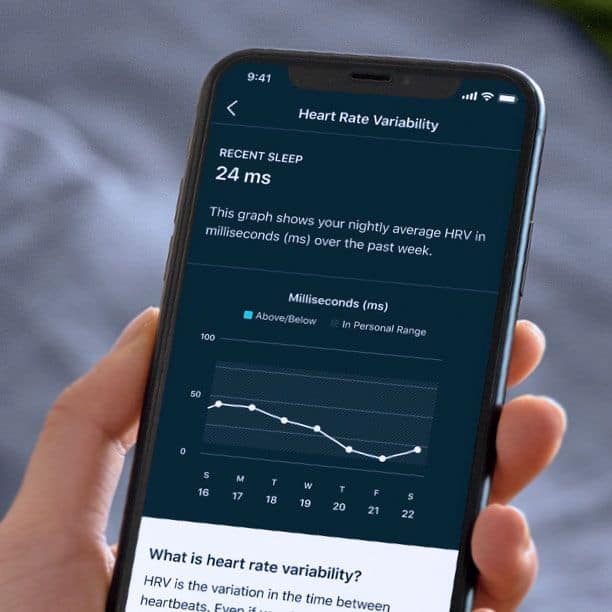
What is heart rate variability and its significance in a nutshell?
Your heart doesn’t beat uniformly. The constant variation in milliseconds between your heartbeats is known as your heart rate variability (HRV).
As a general rule of thumb, High HRV is related to good recovery, general fitness, and a performing body. In contrast, a low HRV signifies overtraining, increased stress levels, or an onsetting illness.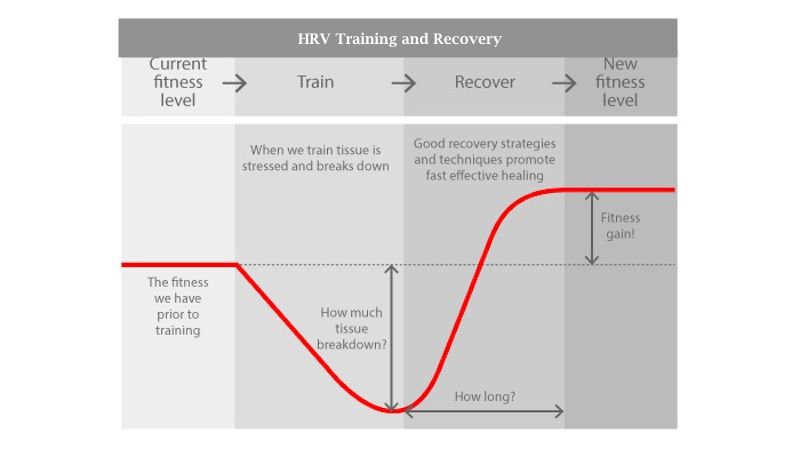
Heart rate variability is unique to each person. A normal HRV for adults can range from below 20 to over 200 milliseconds.
There are factors beyond your control, such as age, sex, and hormones, that affect your HRV, but you can control other parameters, such as your sleep routine, nutrition, and exercise intensity.
Looking at a single day or a week’s HRV reading using your wearable may not provide you with actionable insight.
But if you look at the HRV trends over time as you regularly exercise and take steps to manage your stress, it should be a positive HRV trend line.
Is it possible to improve HRV using training?
The simple answer is yes.
Top exercise physiologists use HRV as one of the tools to determine optimal training loads.
A 2018 study tracked the HRV of elite Rugby players and found that a systems theory approach can accurately model chronic HRV responses to internal training loads within elite Rugby players, which can then be used for optimizing the training process on an individual basis.
Another leading study worked with the NCAA College Football players to evaluate relationships between chronic (i.e., 4-week) heart rate variability (HRV) and training load parameters in 2018 and found that the recovery time interval between training loads played an important role.
In simple terms, if an individual can follow a customized program that modulates the exercise intensity and loads, offers appropriate nutrition guidance for the specific body type, and helps manage stress and improve recovery, the heart rate variability can be improved.
A combination of reduced HRV and significantly elevated Resting heart rate indicates that the body is stressed and not positively adapting to the training stimulus. A good rest and recovery may be in order here.
Therefore, improvements in HRV can be achieved by allowing proper rest and recovery and following regular training that is not too strenuous daily.
Why the push for improved or optimal HRV?
The benefits of improved HRV are many. Focus, sleep, calm, productivity, reduced anxiety and impulsivity, and deeper meditative states.
This requires a lot of discipline and management beyond just measuring the HRV using a smartwatch or fitness tracker.
This is where leading exercise science platforms can come in handy that help you measure the critical elements of your HRV and actually guide you through a roadmap to improve your HRV.
An optimal level of HRV is associated with health, self-regulatory capacity, and adaptability or resilience.
Higher levels of resting vagally-mediated HRV are linked to the performance of executive functions like attention and emotional processing by the prefrontal cortex.
HRV helps monitor autonomic function and assess ANS(autonomic nervous system) involvement in several clinical conditions.
Importantly, low HRV has been predictive of increased risk of heart disease, sudden cardiac death, and all-cause mortality.
HRV has been proven to be valuable, noninvasive clinical evidence for evaluating diseases and even for describing aging and behavior.
Let’s look at some of the best products available for improving HRV
ApolloNeuro stimulus device for improving HRV 
Apollo is a wearable wellness device that, paired with its app, uses gentle vibrations to help your body recover from stress.
Apollo’s scientifically proven technology improves heart rate variability (HRV), a critical biometric of stress, so that you can feel calmer, more balanced, and perform at your best.
Apollo’s wearable technology has been proven to improve HRV and cognitive performance in a placebo-controlled clinical trial at the University of Pittsburg.
Another study with a group of NCAA athletes at the University of Minnesota found that it improved HRV in 40 out of the 40 athletes enrolled in the study.
The wearable doesn’t provide you with analytics around training loads and HRV.
Instead, it focuses on managing stress and recovery (an essential component of HRV improvement) using gentle vibration waves that stimulate your “rest and digest” parasympathetic nervous response and restores balance to the body.
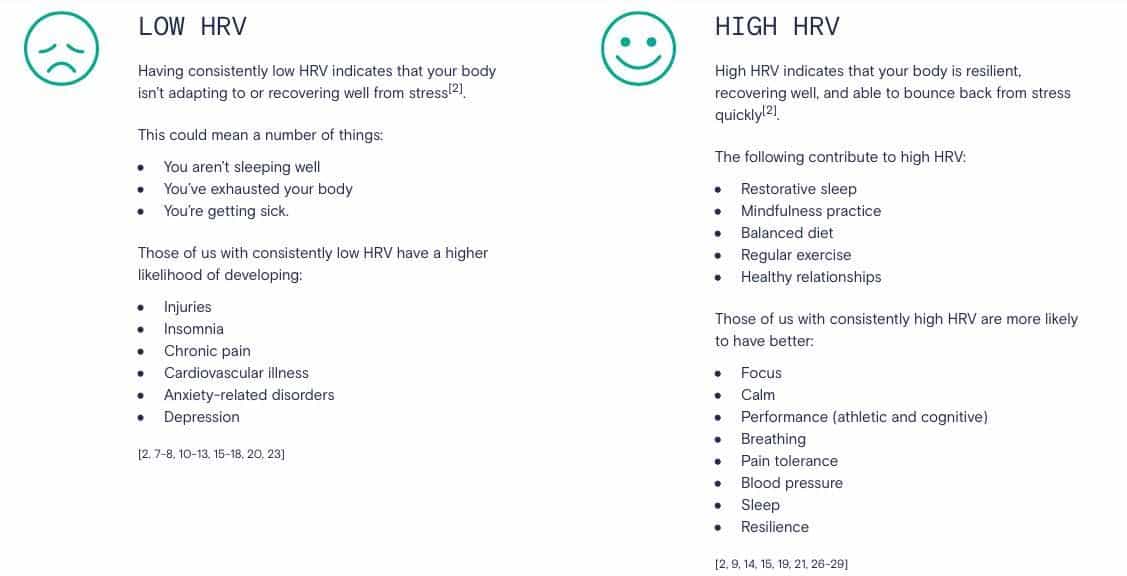
Apollo’s wearable comes with seven curated modes that can use.
Regular users of Apollo tend to typically use the “Energy and Wake Up” mode in the morning, the “Clear and Focused” mode throughout the day, the “Relax and Unwind” mode in the evening before bed, and the “Sleep and Renew” 2 hr mode when laying down to sleep.
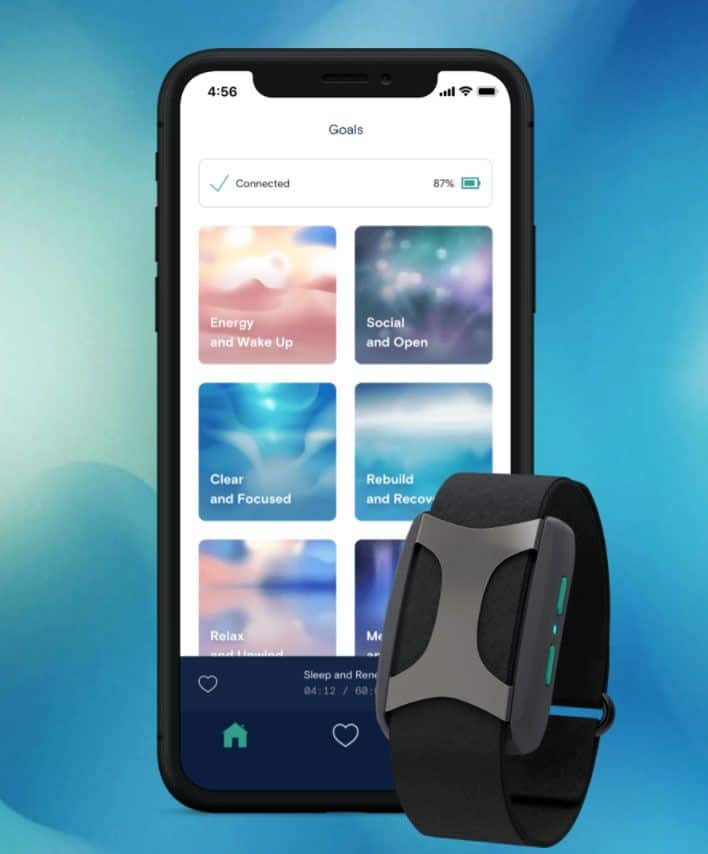
By using Apollo’s patented wearable along with a strict exercise regimen (alternate day cardio and weights) and a balanced diet ( without alcohol consumption), users often see improvements in their HRV over just four weeks.
Beyond achieving a higher HRV via this type of biofeedback device modulating your nervous system, you gain further benefits when using a smart wearable like the Whoop, with its scientific and disciplined approach to managing exercise load (strain) and monitoring recovery metrics.
Many folks use both. Whoop for training and monitoring and Apollo for nervous system stimulation to improve HRV. 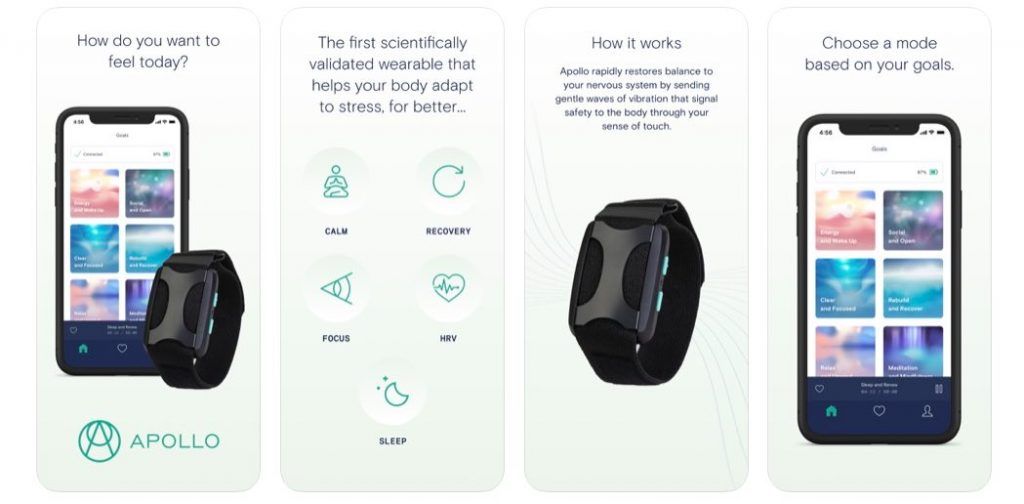
The major drawback of Apollo’s wearable is its pricing and the need to charge it frequently.
The Apollo wearable costs around four hundred dollars and can be ordered directly from its website.
Sadly, the Apollo wearable doesn’t track any of your biometrics at this price point.
It would help if you used a Fitbit, Whoop, or Apple Watch to monitor your biometrics.
Users find that their resting heart rate (RHR), heart rate variability (HRV), sleep latency (the time it takes to fall asleep), and overall sleep quality reliably improve with consistent Apollo use.
Wear it for at least a month to notice its difference.
Whoop 3.0 or 4.0 Fitness Band to monitor and improve HRV
We are big fans of the Whoop at MyHealthyApple.
The hype behind Whoops is warranted, as it’s completely changed how many of us approach exercise and recovery.
Whoop is a no-display fitness tracker that has made a science out of Strain and Recovery, the two most important variables that impact your heart rate variability.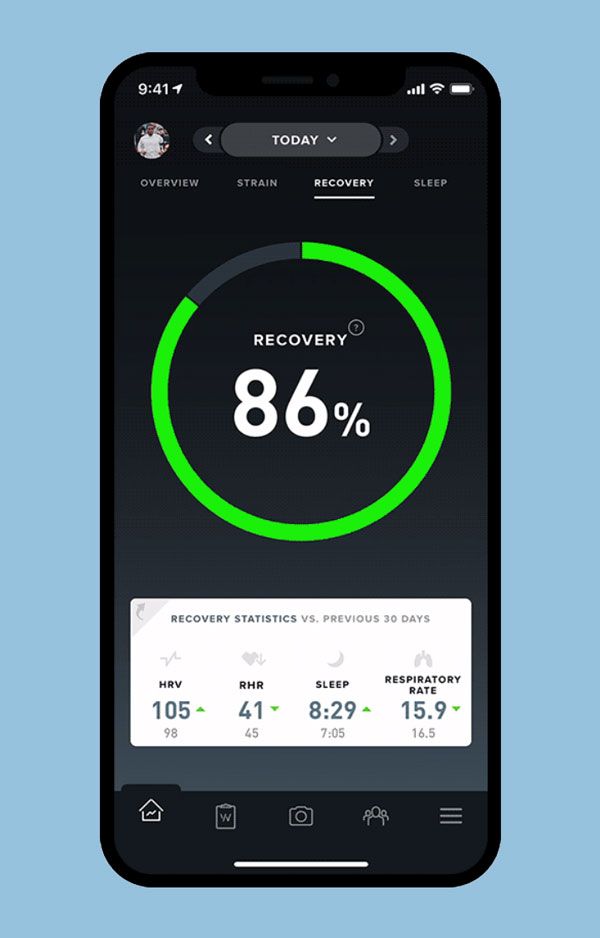
Its detailed sleep monitoring analytics let you see how well you have rested and recovered before loading your system with additional training.
Users use Whoop’s daily journal feature and track as much as they are comfortable with.
Plus, you get monthly reports detailing how your habits impact your heart rate.
Combine the journaling with a meal planning app to get optimized nutrition.
And monitor your biometrics to see your HRV trends.
The good thing with Whoop is that you can sort of do A/B testing, try different exercise intensities, adjust your food and sleep habits, and then see what works best for you! 
Here is what Whoop says about HRV-based training.
Some users see better recovery scores if they incorporate fasting into their diet routine (Just one or two large meals per day).
Contrary to popular belief, other users find their heart rate data superior, with lowered carb intake enough to get into ketosis.
Check out this popular study that determined that after 12 weeks of keto-adaptation and exercise training, participants changed in terms of enhanced body composition, fat oxidation during exercise, and performance measures (relevant to competitive endurance athletes.)
Change your habits!
We all know that late-day or late-night meals and alcohol consumption wreak havoc on sleep and heart rates and negatively impact recovery.
Well, Whoop shows your data on how your bad habits slow your recovery to change those habits that decrease your HRV.
Are you drinking a lot of cups of coffee a day?
Try and reduce it to two cups and monitor your HRV using your Whoop band. You will be surprised!
A fellow workout partner who had suffered some minor spinal cord injuries from an accident could never get his recovery scores and HRV higher because of poor sleep patterns.
After consulting his doctor and taking Lyrica, he saw consistent improvements in his recovery scores.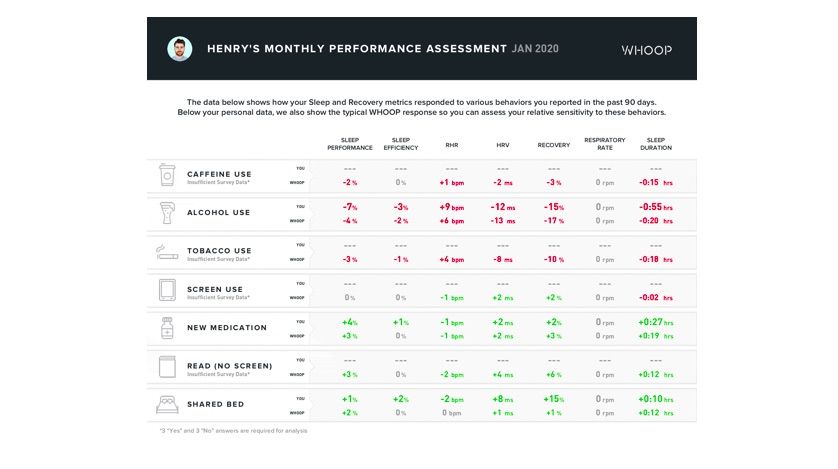
The bottom line is that the Whoop band allows you to monitor your most important biometrics and adjust your lifestyle and exercise regimen so that you can work to improve your HRV and other heart metrics.
You can currently get the Whoop Fitness band for $30/month and try it out yourself.
EliteHRV Heart Rate Variability (HRV) tracking app
If you are a firm believer in “you can’t manage what you can’t measure,” the eliteHRV platform that includes the Elite HRV app and its own house-branded tracker (or a supported third-party heart rate sensor) does not disappoint.
Their CorSense HRV tracker is considered one of the most accurate HRV trackers out there.
It measures accurate HRV through pulse detection using a gold-standard 500-hertz multi-wave sensor array that comfortably slips over your finger.
Although they recommend using their HRV tracker, they can be challenging to find.
The good news is that you can use their Elite HRV app with third-party devices like Polar’s H10, H7, or H9 chest strap HR monitor, the Suunto Smart Belt, and select other heart rate monitors. 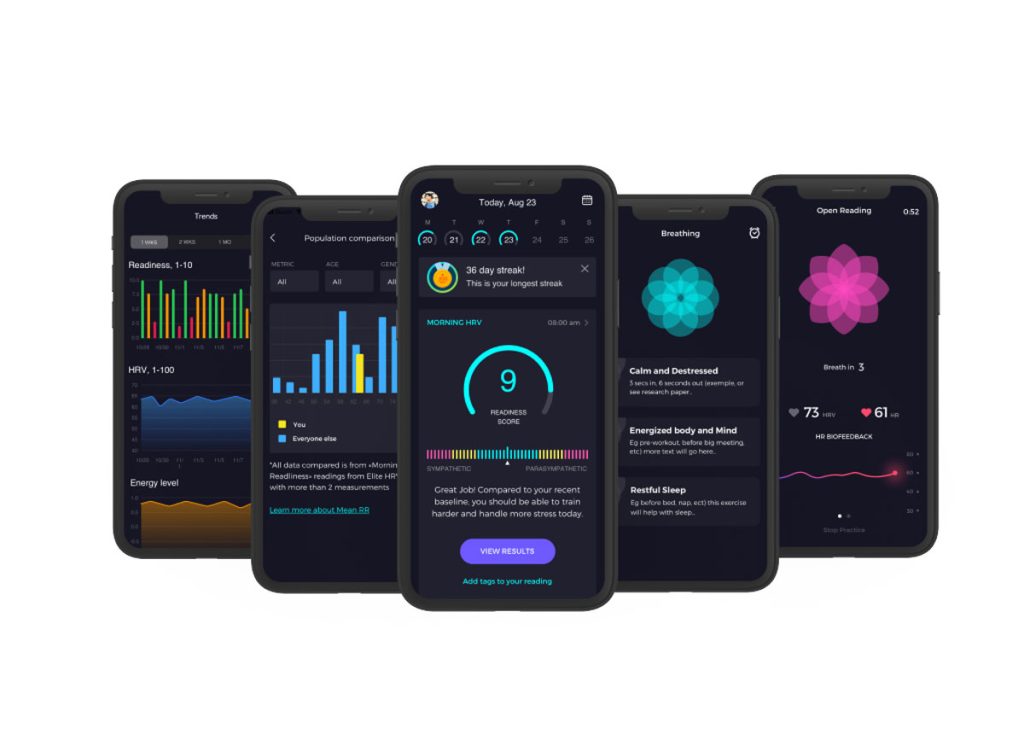
Only a few other products and apps come close to the level of HRV analytics that EliteHRV provides.
The app is simple to use and includes guides and lessons, so you understand all that HRV information! And best of all, the Elite HRV Wellness app is free for you to use (personal use only.)
The EliteHRV analytics provides rich insights around the most important HRV metrics:
- RMSSD – Root Mean Square of the Successive Differences (RMSSD) is one of a few time-domain tools used to assess heart rate variability, the successive differences being neighboring RR intervals
- SDNN – The SDNN is the standard deviation of the normal-to-normal (NN) sinus-intervals measured in milliseconds. This measure reflects the ebb and flow of all factors contributing to HRV.
- PNN50
- LF/HF ratio – The ratio of LF to HF power (LF/HF ratio) may estimate the ratio between the sympathetic nervous system (SNS) and parasympathetic nervous system (PNS) activity under controlled conditions.
- In healthy subjects, LF and HF have a circadian pattern with reciprocal fluctuations. In the daytime, LF increases; in the nighttime, HF increases.
- A low LF/HF ratio could signal low vagal activation. The vagus nerve is an integral part of the parasympathetic nervous system, connecting many organs, such as the brain, heart, liver, and gut. Having a ”low vagal tone” means that the vagus nerve is impaired in functioning and is known as a well-known cause of stress.
CorSense’s EliteHRV also measures the inter-beat intervals (also known as RR or NN intervals) used to calculate your heart rate variability.
In simple terms, the CorSense wearable offers you a rich knowledge set around your body’s ability to handle stress and recovery rate.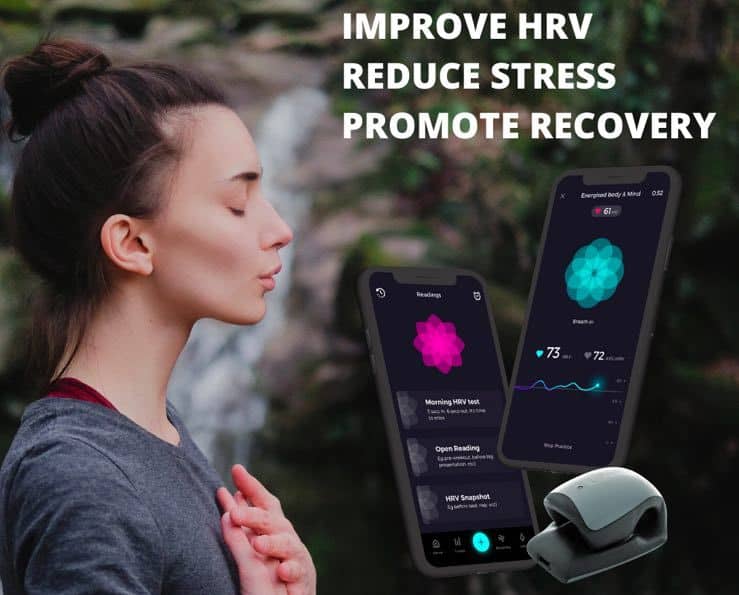
The analytics is not only able to give you the scientific wizardry around your HRV but, more importantly, can answer questions such as:
- Did you get enough quality sleep?
- Did you recover well from your last intensive Peloton endurance 90-minute bike ride?
CorSense also provides live HRV biofeedback and guided breathing exercises.
The Elite HRV app works with both iPhone and Android.
The finger wearable also features a long battery life of aroundsix6 months.
The eliteHRV CorSense is priced at $165, and for that price, you are getting a near medical-grade HRV monitor with stellar analytics.
Plus, it’s been used in numerous clinical trials.
And the eliteHRV is backed by a 30-day guarantee.
Notable mentions of other HRV training products
Heartmath emWave
HeartMath offers the emWave 2 product for $149.25 that monitors your HRV.
It also offers a bunch of well-researched training programs.
In those programs, you can learn how to reduce and prevent the negative effects of stress, such as fatigue and exhaustion, sleep disruption, anxiety, and burnout.
The platform’s Interactive Coherence Coach teaches you an essential HeartMath self-regulation technique.
We have not tried the emWave offering and can’t provide you with additional insights.
But it’s definitely an option for people looking for a guided training program to improve their HRV and are not too concerned with geeking out on HRV metrics.
Xen by Neuvana
These earbuds incorporate vagus nerve stimulation (VNS) technology, which is scientifically proven to improve sleep quality, lower stress levels, and elevate mood.
The vagus nerve activates the parasympathetic nervous system and functions as a button you can press to reduce stress.
The companion Neuvana app lets you easily customize and control your Xen session. Plus, new VNS waveforms are introduced all the time.
There has been a lot of research(4) around transcutaneous vagus nerve stimulation and its effects on stress reduction and overall health.
The Neuvana Xen product falls into this category.
Many users observe benefits and improvement in their HRV when consistently using this stimulator for a few months.
Users who experience nausea symptoms when faced with high anxiety have found this low-risk device very helpful.
This is another product we have not tried, and it is pricey at $400 with additional monthly subscription fees for the app.
We hope to try it out soon and provide you with a detailed review of our findings.
HRV Training using your Apple Watch
If you currently own an Apple Watch (Series 4 and higher), it tracks your heart rate details AND captures HRV metric details.
Starting with iOS 13 and watchOS 6, many of the handicaps that existed with Apple watch HRV calculation (accessing RR intervals via Apple Health) are gone.
The availability of RR intervals via the Health app essentially means that developers are not limited and can compare rMSSD and analyze signal quality.
This change renewed some third-party developers to build more functionality around HRV analytics.
One of the leading third-party developers in this area is Marco Altini, the founder of HRV4Training.com.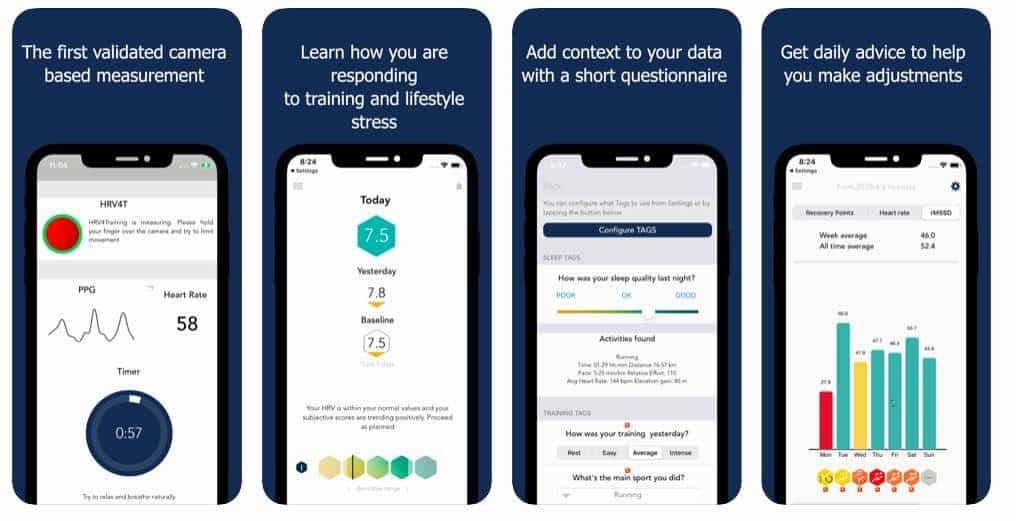
The HRV4Training app on the iPhone provides important HRV-based insights that you can use for your training.
You can check out some of his musings on Medium and the app offerings using your Apple Watch to use detailed RV-based training.
Training Today app on Apple Watch
Another third-party Apple Watch app that is gaining popularity is Training Today.
If you like Whoop’srecovery-basedd science but are not yet ready to pay the monthly subscription, this might be one of the best Apple Watch apps to try out that can offer insights into Recovery science.

Training Today recommends daily training levels by looking at your Apple Health data and presenting a simple color-coded recommendation and chart.
The user interface is very intuitive, and the app is free.
Training Today app uses the Heart Rate Variability (HRV) and Workout detection from your Apple Watch and its algorithm to establish an RTT (Readiness to train) score. If needed, you can force a new HRV reading by using the Apple Breathe app while using Training Today’s app.
This is probably one of the best HRV training apps that we have seen for Apple Watch users.
Combine this with Apple’s built-in sleep tracking or an app like Auto-sleep, and you have covered the core HRV components around recovery.
Summary
We hope this article provided you with some important insights and resources about HRV Training.
Please let us know if you have any questions or would like to share an app or your experiences with a new product that is helping you maintain an optimal HRV.
Resources:
1. An overview of Heart rate Variability metrics and norms
4. Transcutaneous Vagus nerve stimulation and associated effects


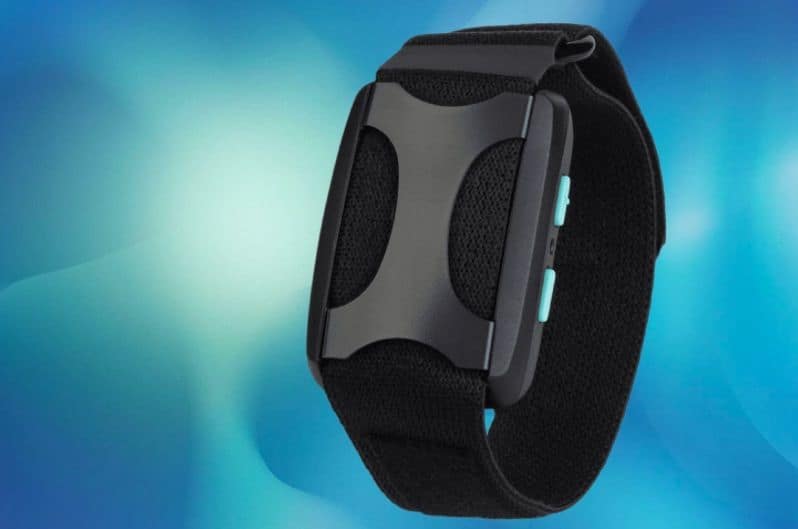
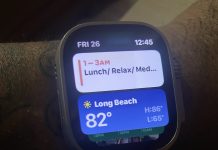
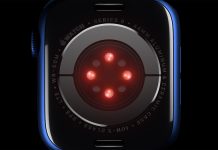
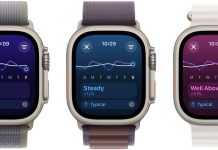



Have you looked into the Athlytic app? It is the closest thing on Apple to Whoop or Garmin imo
Hi Mike,
Thanks for the heads up on this app–we’ll take a look and maybe add it or do a review.
Cheers,
Amanda
What about Getlief wearable for HRV? How does it compare in accuracy to other methods?
HI James,
The Lief is a newcomer on the scene, but a recent small clincal study (one of the authors is Lief’s Head of Behavioral Health Communication and has an equity stake in the company) found that users self-reported reduced symptoms of anxiety and depression and collected HRV data showed that participants increased their HRV (RMSSD) by an average of + 11.4 ms after using the Lief during the 8-week study.
There are a couple of key differences with the Lief smart patch, including a hefty $99/month subscription fee for the device rental and its Lief Coach services.
Corsense units are junk. Their warranty has dropped from 90 days to 45 days. They now sell used/returned units. Why? They don’t connect half the time and they have high return rates.
What will your HRV be while trying to troubleshoot tech issues? High. Skip this and look elsewhere.
Measuring HRV using wearables has proven difficult. Taking readings while in motion affects the accuracy of the readings, and creates noise in the data. For accuracy, it is best to take the readings first thing in the morning while in a calm rested state.
It’s also important to be aware that there are two measures for HRV, the rMSSD and the standard deviation (SD) of the IBI. Both are measured in milliseconds, but they differ in absolute terms. The Apple watch uses the SD, not the rMSSD. The most reliable wearable for measuring the IBI at present is the Polar H10 HRM, which both Kubios and Elite HRV use with their apps.
In order to have the best personal overview it is a must, to combine HRV and HR measurements and creating an Index. HR is an Index for physical load, HRV for the mental load. Body Energy, Overtrainig, Stress and Recovery depend heavily on both components.
Load Index=a HR + b HRV